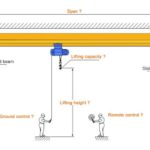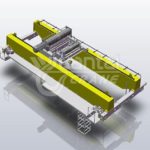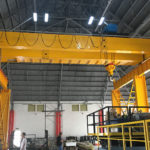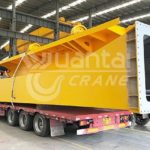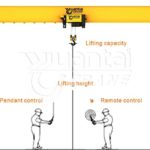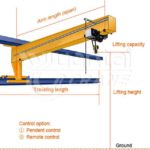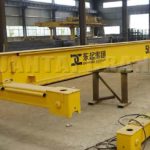Jib Crane Installation | Jib Crane Assembly
A jib crane is a type of crane that has a horizontal arm, called a jib, that supports a hoist. Jib cranes are used to lift and move heavy objects in various industries, such as manufacturing, construction, and warehousing. Jib cranes can be mounted on walls, floors, or columns, depending on the space and load requirements.
To install a jib crane or the assembly of a jib crane, you need to follow these steps:
- Choosing the right location and type of jib crane for the application, considering the clearance, power supply, and foundation requirements.
- Prepare the foundation for the jib crane, either by bolting it to an existing concrete floor or by pouring a new concrete base with embedded anchor bolts.
- Assemble the jib crane components, such as the mast, the boom, the hoist, and the trolley, following the manufacturer’s instructions and using the appropriate tools and equipment.
- Attach the jib crane to the foundation, either by tightening the anchor bolts or by welding the base plate to the column.
- Connect the electrical wiring and controls to the jib crane, following the wiring diagram and safety precautions.
- Testing the jib crane for proper operation and safety.
- Perform regular maintenance and inspection of the jib crane.
Jib Crane Mounting Brackets
Jib crane mounting brackets are essential components for installing and securing jib cranes to the floor, wall, or ceiling. They provide stability and support for the crane’s mast and boom and allow for smooth and safe operation of the crane. Jib crane mounting brackets come in different sizes, shapes, and materials, depending on the type and capacity of the jib crane. Some common types of jib crane mounting brackets are:
- Floor-mounted brackets: These are used for floor-mounted jib cranes, which are fixed to a concrete foundation. Floor-mounted brackets are usually made of steel or cast iron, and have holes or slots for anchoring bolts. They may also have leveling nuts or shims to adjust the height and alignment of the crane.
- Wall-mounted brackets: These are used for wall-mounted jib cranes, which are attached to a structural wall or column. Wall-mounted brackets are typically made of steel or aluminium and have flanges or plates for bolting to the wall. They may also have gussets or braces to reinforce the connection and prevent bending or twisting of the bracket.
- Ceiling-mounted brackets: These are used for ceiling-mounted jib cranes, which are suspended from a ceiling beam or truss. Ceiling-mounted brackets are usually made of steel or aluminium and have clamps or hooks for attaching to the ceiling. They may also have swivels or bearings to allow for rotation of the crane.
Jib crane mounting brackets should be selected according to the specifications and requirements of the jib crane, such as its weight, span, rotation angle, and lifting capacity. They should also be compatible with the surface and structure where the jib crane will be installed. Jib crane mounting brackets should be installed by qualified professionals, following the manufacturer’s instructions and safety guidelines. Proper installation and maintenance of jib crane mounting brackets can ensure optimal performance and longevity of the jib crane.
Jib Crane Requirements | Jib Crane Foundation Requirements
Jib crane requirements are the specifications that a jib crane must meet to operate safely and efficiently. Jib cranes are a type of crane that has a horizontal boom attached to a vertical mast and can rotate around the mast to lift and move loads. Jib cranes are commonly used in workshops, warehouses, docks, and other industrial settings.
Jib crane foundation requirements are the criteria that the base of the jib crane must satisfy to support the weight and movement of the crane. The foundation must be strong enough to withstand the vertical and horizontal forces exerted by the crane, as well as the dynamic effects of wind, vibration, and impact. The foundation must also be stable enough to prevent the crane from tipping over or shifting. The foundation must be designed according to the soil conditions, the type of jib crane, and the load capacity of the crane.
Jib Crane Standards
Jib cranes are subject to certain standards and regulations that ensure their safety and performance. These standards may vary depending on the country, industry, or application of the jib crane. However, some common standards that apply to most jib cranes are:
- ANSI/ASME B30.17: This standard covers the design, construction, installation, inspection, testing, maintenance, and operation of overhead and gantry cranes with underhung hoists, including jib cranes.
- ISO 4301-1: This standard classifies the general use and duty of cranes based on their load spectrum, load cycles, and operating conditions.
- ISO 8686-1: This standard specifies the general principles for establishing the allowable loads and load combinations for cranes.
- OSHA 1910.179: This standard regulates the occupational safety and health requirements for overhead and gantry cranes, including jib cranes.
These standards provide guidelines and requirements for the safe and efficient use of jib cranes. They cover aspects such as load capacity, stability, structural integrity, inspection, testing, training, signalling, emergency procedures and more. It is important to follow these standards to ensure the safety of workers, equipment and materials.

